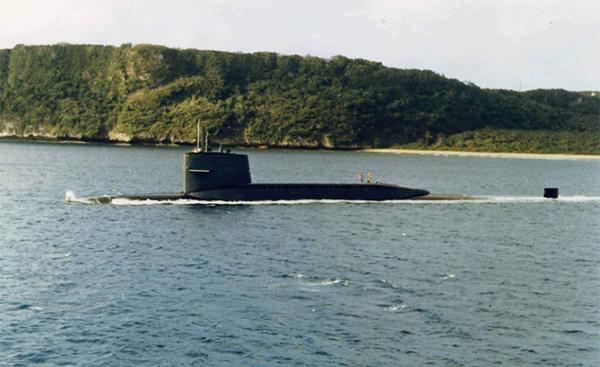Calling to foreign ports: a re-emerging practice for US nuclear-armed submarines?
Recherches & Documents n°15/2023
Emmanuelle Maitre,
Alda Anindea,
November 17, 2023
Summary
The latest visit of the USS Kentucky (SSBN-737) to Busan, South Korea, on 18 July 2023 has gained media attention worldwide as it marked the first time a US ballistic missile submarine (SSBN) conducted a port visit to South Korea in four decades“US Nuclear-Armed Submarine Visits S. Korea for First Time in Decades”, The Defense Post, 18 July 2023.. During the Cold War, the US Navy arranged SSBN visits in foreign ports regularly, but post-Cold War the frequency of these calls has decreased significantly. However, even if the media still qualify them as “rare” and “unusual”, port visits have started to become more prominent since 2015. This change of pattern raises questions on the rationale for this increase in port visits after the practice was almost given up for twenty years. This analysis describes the change of attitude of the US Navy towards sending its SSBN to foreign ports, sheds light on the reasons that pushed the United States to discontinue these operations and explains the importance of port visits in the current context.
Introduction
Since the 1960s, the United States has relied extensively on its nuclear-powered ballistic missile submarines (also known as boomers) as part of its strategic nuclear force, constituting the largest fleet in the worldBarbara Starr, “US Navy sends message to adversaries with a rare submarine port visit in Indian ocean”, CNN, 2 December 2022.. These submarines are armed with nuclear-tipped submarine-launched ballistic missiles (SLBM). The latest Ohio-class SSBN carries up to twenty D-5 Trident ballistic missilesTony Capaccio, “U.S. submarines are popping up more often and it’s not clear why”, The Japan Times, 6 May 2023.. The ability to sail undetected around the globe and to keep submarines permanently at sea provides the United States with an assured second-strike capacity, since it is virtually impossible to destroy the SSBN fleet in a preventive strike. The stealth of the SSBNs allows them to operate in silence, undetected, and untraceable, owing them the nickname of “the Navy’s silent service”Ibid.. Protecting its invulnerability, and especially preventing potential adversaries from tracking it on the high seas, is a major priority for a SSBN. This means that its patrol are usually shrouded in secrecy. As each SSBN carries highly attractive data for any potential adversary interested in tracking the vessel, port visits may appear unadvisable for these submarines. Indeed, they may open up vulnerabilities and offer intelligence gathering opportunity if potential adversaries are informed that SSBNs will be docking at a specific locationMasashi Murano, “What are the appropriate SSBN forward deployment options?”, Hudson, 5 May 2023.. Despite these potential risks, US SSBNs stopped at foreign ports during the Cold War and more recently. Each time it decided for it, the US government visibly considered that the benefits provided by port calls outweigh the possible risks entailed.
The first SSBN to call on a foreign port was the USS John Marshall (SSBN-611), which docked in Izmir (Turkey) in 1962. Since that date, port visits have played an important but discreet role in the US naval mission and as of 2023, Washington has conducted foreign port visits to at least 22 countries, including, to name a few, South Korea, the United Kingdom, Canada, and Italy. Over the course of forty years, from 1962 to 2000, the Navy conducted at least 160 port visitsThis data is collected from open-source archives and documents, and may not be exhaustive as patrol history has been largely underreported and kept secret. Main sources used include Hans M. Kristensen and Robert S. Norris, “A History of US nuclear weapons in South Korea”, Bulletin of the Atomic Scientists, vol. 73, n° 6, Fall 2017, and Brent Alan Ditzler, “Naval Diplomacy Beneath the Waves: A Study of the Coercive Use of Submarines Short of War”, Master’s dissertation, Naval Postgraduate School, 1989, pp. 97-99, as well as official and non-official history pages of the SSBNs, official archives of patrol and sailor’s personal testimonies.. Most noticeably, the submarines went to British and South Korean ports more than to any other countries, with continuous visits to Chinhae (South Korea) in 1976-1981. However, there was a steady decline in 1990-2000, with probably only around 20 port calls during that decade, before the United States eventually stopped conducting port visits for fifteen years (2000-2015). The resumption of visits to South Korea but also to other parts of the globe is an interesting testimony of the ongoing geopolitical changes and may reflect several important political, operational and strategic priorities for the United States and its allies.
[...]
To read this version, please download the file below.

Calling to foreign ports: a re-emerging practice for US nuclear-armed submarines?
Recherches & Documents n°15/2023
Emmanuelle Maitre,
Alda Anindea,
November 17, 2023